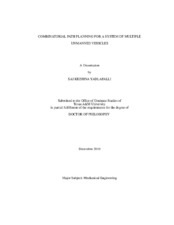| dc.contributor.advisor | Darbha, Swaroop | |
| dc.contributor.advisor | Rajagopal, Kumbakonam R. | |
| dc.creator | Yadlapalli, Sai Krishna | |
| dc.date.accessioned | 2011-02-22T22:24:46Z | |
| dc.date.accessioned | 2011-02-22T23:50:26Z | |
| dc.date.available | 2011-02-22T22:24:46Z | |
| dc.date.available | 2011-02-22T23:50:26Z | |
| dc.date.created | 2010-12 | |
| dc.date.issued | 2011-02-22 | |
| dc.date.submitted | December 2010 | |
| dc.identifier.uri | https://hdl.handle.net/1969.1/ETD-TAMU-2010-12-8960 | |
| dc.description.abstract | In this dissertation, the problem of planning the motion of m Unmanned Vehicles (UVs) (or simply vehicles) through n points in a plane is considered. A motion plan for a vehicle is given by the sequence of points and the corresponding angles at which each point must be visited by the vehicle. We require that each vehicle return to the same initial location(depot) at the same heading after visiting the points. The objective of the motion planning problem is to choose at most q(≤ m) UVs and find their motion plans so that all the points are visited and the total cost of the tours of the chosen vehicles is a minimum amongst all the possible choices of vehicles and their tours. This problem is a generalization of the wellknown Traveling Salesman Problem (TSP) in many ways: (1) each UV takes the role of salesman (2) motion constraints of the UVs play an important role in determining the cost of travel between any two locations; in fact, the cost of the travel between any two locations depends on direction of travel along with the heading at the origin and destination, and (3) there is an additional combinatorial complexity stemming from the need to partition the points to be visited by each UV and the set of UVs that must be employed by the mission.
In this dissertation, a sub-optimal, two-step approach to motion planning is presented to solve this problem:(1) the combinatorial problem of choosing the vehicles and their associated tours is based on Euclidean distances between points and (2) once the sequence of points to be visited is specified, the heading at each point is determined based on a Dynamic Programming scheme. The solution to the first step is based on a generalization of Held-Karp’s method. We modify the Lagrangian heuristics for finding a close sub-optimal solution.
In the later chapters of the dissertation, we relax the assumption that all vehicles are homogenous. The motivation of heterogenous variant of Multi-depot, Multiple Traveling Salesmen Problem (MDMTSP) derives form applications involving Unmanned Aerial Vehicles (UAVs) or ground robots requiring multiple vehicles with different capabilities to visit a set of locations. | en |
| dc.format.mimetype | application/pdf | |
| dc.language.iso | en_US | |
| dc.subject | Path Planning | en |
| dc.subject | Hamiltonian Path Problem | en |
| dc.subject | Multiple TSP | en |
| dc.subject | Approximation Algorithms for MTSP | en |
| dc.subject | MDMTSP | en |
| dc.subject | Heterogeneous TSP | en |
| dc.subject | Heterogeneous MSF | en |
| dc.subject | Lagrangian Relaxation | en |
| dc.title | Combinatorial Path Planning for a System of Multiple Unmanned Vehicles | en |
| dc.type | Book | en |
| dc.type | Thesis | en |
| thesis.degree.department | Mechanical Engineering | en |
| thesis.degree.discipline | Mechanical Engineering | en |
| thesis.degree.grantor | Texas A&M University | en |
| thesis.degree.name | Doctor of Philosophy | en |
| thesis.degree.level | Doctoral | en |
| dc.contributor.committeeMember | Rathinam, Sivakumar | |
| dc.contributor.committeeMember | Butenko, Sergiy | |
| dc.contributor.committeeMember | Rasmussen, Bryan | |
| dc.type.genre | Electronic Dissertation | en |
| dc.type.material | text | en |


